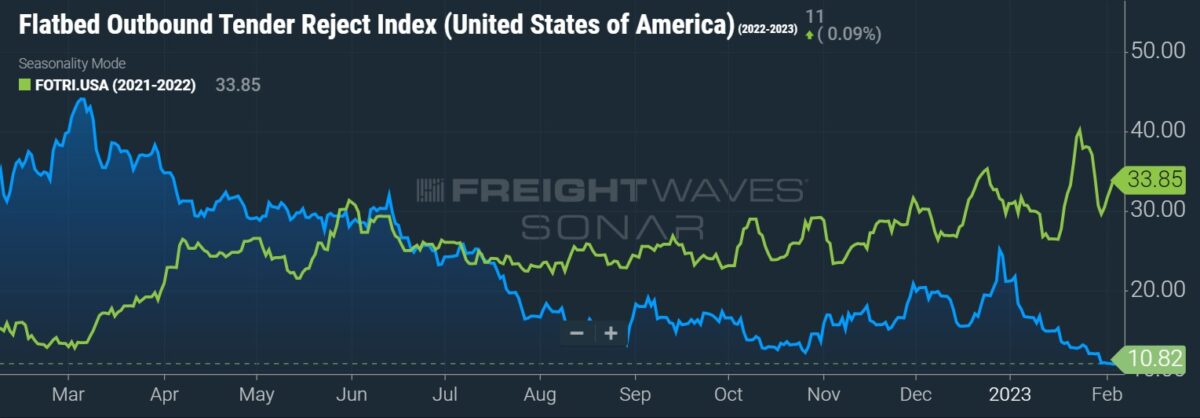Management from flatbed truckload operator Daseke said it expects to see demand improve by the middle of the year, in line with normal seasonality, with rates returning to 2022 peak levels next year. It also sees the industry reaching a fresh peak for rates in 2025.
Daseke (NASDAQ: DSKE) reported fourth-quarter adjusted earnings per share of 25 cents Monday before the market opened, which was ahead of the consensus estimate of 6 cents. During the quarter, it repurchased roughly 30% of its outstanding shares, including $108 million from founder Don Daseke.
The consensus number may have not included the full impact from the stock buyback. Adjusted net income was 21% higher year over year (y/y) at $15.7 million. Adjusted EPS during the period was 27 cents on a pro forma basis adjusted for the share repurchases.
Management’s 2023 outlook calls for revenue, including and excluding fuel surcharges, to be flat to up by a low-single-digit percentage y/y, with adjusted earnings before interest, taxes, depreciation and amortization level with 2022.
Daseke plans to add 100 to 150 trucks to the fleet this year and improve miles per truck by 8% to 10%. It will also continue to replace owner-operators with company drivers, who operate at a better margin, now that the driver labor market has loosened. The insurance expense line is also expected to be lower y/y. However, much of the performance in the year will be tied to rates.
“It comes down to rate. At the end of the day, for all of us in this industry, rate is the biggest thing out of our control that will kind of make or break things,” CEO Jonathan Shepko told analysts and investors on a call Monday.
He said contract rates stepped down in July, falling faster in October and November as some shippers put freight out for bid knowing carriers would be hungry to lock down contractual commitments heading into the flatbed industry’s seasonally weakest part of the year, the fourth and first quarters. He said shippers were “really playing on everybody’s concerns, expectations that it could get a little tougher.”
Shepko said contract rates have firmed in recent weeks but noted that shippers are also looking to rebid some freight in April, ahead of peak season, “before you have a good sense of really how good Q2 and Q3 is going to be for you.”
Between 80% and 85% of Daseke’s business falls under contract.
Shepko is bullish on the rate outlook in general, pointing to an internal expectation that rates will reach 2022 peaks again next year, stepping to new highs by 2025.
Referencing the duration of prior cycles and the expectation that many carriers will fail on the downside of this cycle, he said: “I just think the rate environment’s at the bottom. We’ve never had a Q2 or Q3 where we haven’t benefited with some kind of uplift and seasonality.
“If you take the trough that we had in the Great Recession, we were back to 80%, 90% of pre-recession peak rates within 12 months.”
Full-year 2022 consolidated revenue was 14% higher y/y at $1.77 billion and in line with management’s guidance calling for 12% to 15% growth. Adjusted EBITDA of $235 million was 5% higher y/y, at the low end of a 5% to 10% growth forecast.
Daseke’s prior guidance assumed 2023 would end at an annual EBITDA run rate at least $25 million higher than in 2022. The new outlook assumes the exit run rate is up by $20 million to $25 million.

Q4 highlights
Consolidated revenue in the fourth quarter was 4% higher y/y at $408 million, down 2% excluding fuel surcharges.
Daseke’s specialized unit recorded an 11% y/y increase in revenue largely due to a lift in brokerage revenue. Freight revenue increased 3% as average tractors in service grew by 162 units to almost 2,500, but revenue per tractor fell 4%. The company saw good demand for high-security cargo and from the agriculture and aerospace markets. This offset weakness for construction- and renewable energy-related freight demand.
The segment posted a 91.8% adjusted operating ratio, which was 110 basis points better y/y.

The company’s general flatbed division reported a 6% y/y revenue decline as a 2% increase in tractor count was offset by a 10% drop in revenue per tractor, mostly the result of a 9% decline in miles per unit. A 95.9% adjusted OR was 410 bps worse y/y due to higher maintenance and driver costs as well as the decline in revenue.
Across the platform, operations and maintenance expenses were 110 bps higher as a percentage of revenue as the percentage mix of company-owned tractors increased 320 bps. Purchased transportation expense as a percentage of revenue was down 260 bps.
Daseke generated $136 million in free cash flow, ending the year with $153 million in cash on the balance sheet and $264 million in total liquidity. Net debt of $514 million stood at 2.2x trailing EBITDA, an increase from 1.9x last quarter. The change was due to the repurchase of shares.
The company issued a long-term net leverage target of 1.5x to 2x over time, ending 2023 near the top end of the range.
Shares of DSKE were up 11.6% at 1:54 p.m. EST Monday compared to the S&P 500, which was down 0.7%.
More FreightWaves articles by Todd Maiden
- Recent acquisitions weigh on Heartland Express’ Q4
- ArcBest’s Q4 light of analysts’ expectations
- Schneider’s 2023 outlook better than expected











